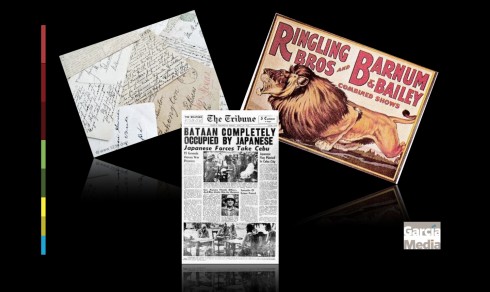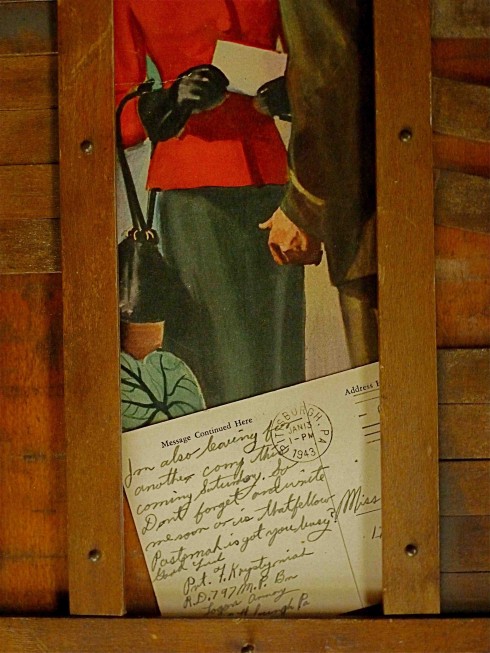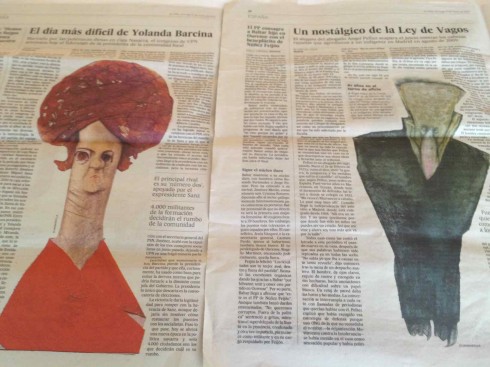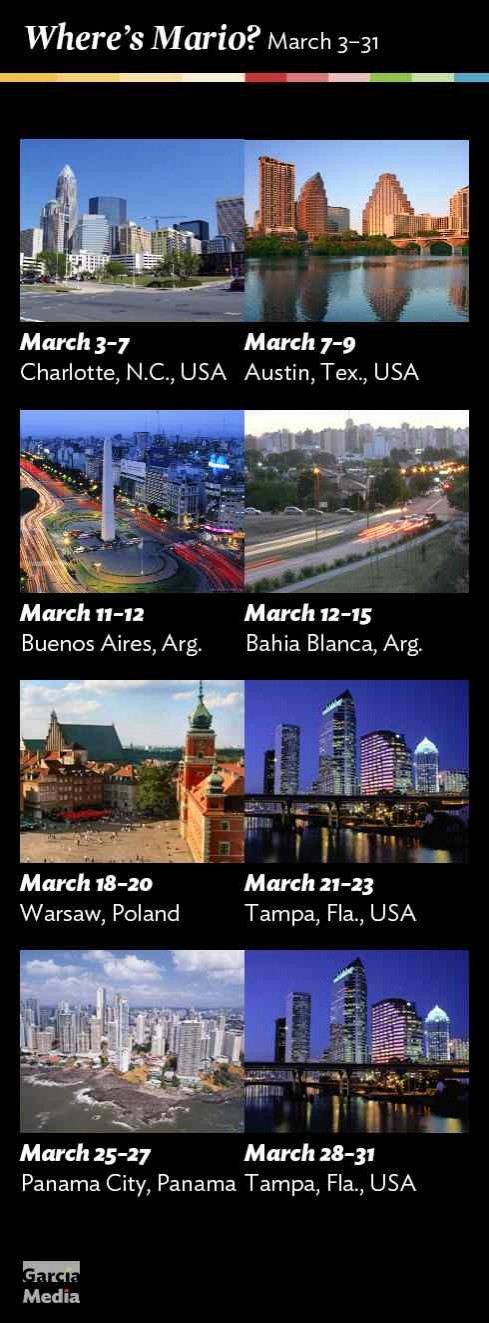TAKEAWAY: These are a few of my favorite things, as well as three sources of nostalgic commentary these days, all considered to be areas in decline, depending on who you talk to or what you read. Let’s say that the handwritten letter, the circus and the newspaper are not exactly how they used to be, but they are still around in some form, in a state of transition. PLUS: Speaking at the Power to Designers conference in Warsaw, Poland today

I tend to like reading sweet reminiscings of things that have disappeared or are no longer how we remember them. Among newspaper people, there is plenty of commentary, and not all sweet. In fact, some talk about the death of the newspaper as if it had already happened. During the weekend, my reading included such sweet reminiscing about such topics as the satisfaction one derives from writing a note by hand (not an email, mind you), or attending a circus performance.
Not that the purpose of any of these areas has disappeared or become obsolete. Quite the contrary. We write more messages today than we probably did in the 19th century, and today’s circus can be a sophisticated high-end affair without messy elephants or insulting clowns. And, of course, we are consuming more news than ever before, except we do so via digital platforms more often than on a printed sheet.
In a recently published book appropriately titled The Missing Link, Philip Hensher, a British novelist who is also a columnist for The Independent and an arts critic for The Spectator , romances those handwritten letters that we see less of today. He believes that handwriting fills a human need: “It involves us in a relationship with the written word which is sensuous, immediate and individual. It opens our personality out to the world, and gives us a means of reading other people.”
Those handwritten letters

Mixed-media assemblage by J. Ford Huffman. Incorporates found objects including illustration by F. Schmidt from advertisement in “Liberty” magazine 15 April 1944. Card addressed to Miss Victoria Zimmach, Baltimore, Maryland, postmarked Pittsburgh 1943. Vintage toy plastic truck. Honor-roll board embossed “1944.” Handwritten message on the card: “I’m also leaving for another camp this Saturday. So Don’t forget and write me soon or is that fellow Pasternak is got you busy? Good Luck, Pvt F Krystyniak..Logans Armory, Pittsburgh”
I admit that I often miss the pure connection that writing a letter by hand could create. Indeed, I still feel something special when I find a note written on the back of a photograph written by a dear relative who is no longer with us. My parents’ letters to me when they sent me to the US while they remained in Cuba are still something I treasure. Dad’s handwriting was powerfully decisive, exaggerating the descenders of letters, almost melodic, like notes on a pentagram, which was appropriate for my musician father. My mother’s was more slanted to the right than it had to be. All I have to do years later is see one word written by either one of them and I know who wrote it, the memories rushing back. Sometimes it is just a date and a place behind a photo of my childhood, such as “Varadero, 1956”.
I also admit that other than a simple Love You in front of my signature for a birthday card, I have not written many extensive notes to my own children or grandchildren so that they will be able to connect with me via my handwriting style. Emails, yes, handwritten letters and notes, few.
This book makes me wish to correct that.
For children of all ages!
We all have the memory of a trip to the circus, the excitement of clowns, acrobats and tamed animals, along with the corresponding smells that such menagerie produced. But Duncan Wall laments in a New York Times column that at least in the US, the circus is in decline, unlike in Europe, where it is booming.
Today, circus companies have a hard time finding the money, time or space to create new work. There are no state-subsidized national circus schools to offer professional training, as there are in Europe, forcing many promising artists abroad, ” he writes.
He seems to find a reason why this is, too:
Hundreds of American universities offer degrees in theater and dance; not one allows a student to graduate in circus. Venues resist programming circus shows and granting bodies resist supporting them. The New York State Council on the Arts has banned “variety” funding outright, including for circuses.
But he also praises such new circus acts like Cirque du Soleil, the Canadian company that sells more tickets annually than all of Broadway combined.
Perhaps Cirque du Soleil is to the circus what a tablet edition is to a newspaper. More streamlined, cleaner on your fingers, and NOT the real thing if you wish to hold paper in your hands, but a variation of the original. It requires adapting, changing your views to accommodate a new version of what you remember, whether it is the email letter as opposed to the handwritten one, or the “luxury” circus without the messy animals, or that newspaper that is not printed, but informs you almost the same.
A man of my age definitely misses all of the originals, but I also like all of the new variations.
And, as for handwritten notes, I always have my good friend J Ford Huffman in Washington, DC., a journalist and a gentleman who knows that a handwritten note never goes out of style. I usually come home to find one such note from J Ford.
Alert: I am coming home this Thursday!
El Pais: illustrations

Illustrations as they appeared on inside pages of El Pais (Monday, March 18)
What a pleasant visual surprise to be browsing through the March 18 print edition of Spain’s El Pais and finding two fabulous illustrations on two different routine inside pages. Nothing routine about those illustrations, however.
While we all know the allure and power of illustrations, it is a fact that we tend to see fewer of them these days. That is why I was amazed to see that El Pais had two of them, on pages 22 and 26, unlikely locations for such outstanding illustration work.
Hope other newspapers take a hint from El Pais. I would have had no interest whatsoever on either one of the stories illustrated but the illustrations made me curious enough to read them.
That is the ultimate test of visual seduction. Bravo to El Pais. ¡Muy bien!
Forbes en español
While discussing Spain, some good news coming out of Madrid where Forbes, the premiere US business magazine, will launch a Spanish edition this month, in collaboration with SpainMedia, according to a story in the International Herald Tribune.
Spain is going through some tough times economically, so many may wonder why Forbes would decide to enter the Spanish market. To me it makes perfect sense. If there is ONE news content topic that the Spanish are very interested in today is the economy. Forbes may have a good idea to launch this edition at this point. It also opens up jobs for journalists, designers, economists, a good thing for a country where unemployment among the young current stands at 55%.
Andrés Rodriguez, the publisher and founder of SpainMedia, is quoted in the Ith piece as quite optimistic, stating that he sees the publishing sector returning to its “golden era”.
We definitely hope so, and will be taking a look at Forbes en Español when it premieres.
Power to Designers

I am in Warsaw today to participate in the one-day Power to Designers conference organized by Jacek Utko, Design director at Bonnier Business Press International. I will be speaking about Storytelling in the Age of theTablet as part of a program that involves design in its various manifestations. In terms of journalistic design, the program covers print and digital. Other sessions cover design of posters, street signs and branding.
For more details go here: http://konferencje.pb.pl/conference/644,power-to-designers
I plan to report from the conference in the Wednesday blog post.
Where’s Mario until March 21, 2013?

Mario’s upcoming speaking engagements

Take advantage of our iPad Design/Ad Lab workshops

Do you want to take your brand to the next level by creating a tablet edition? Garcia Media can help. We now offer one- to two-day iPad Design Lab workshops on demand to jumpstart your presence on this exciting new platform. We also offer iPad Ad Lab workshops to develop engaging advertising models for your app. Contact us for more information.

Purchase the book on the iBookstore